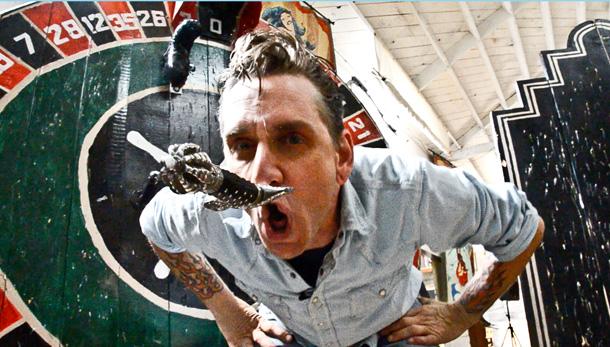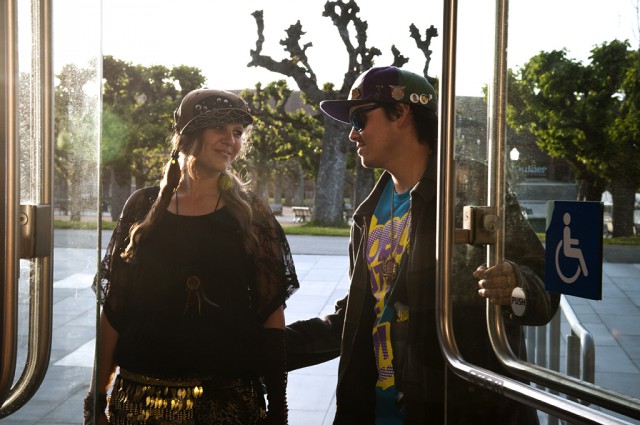Kickstarter is a website for anyone who wants to create a project, self-promote, and raise funds. Based in New York City, Kickstarter consists of a team of thirty-six people. The website allows anyone around the world to pledge the amount of money they need for a project, try to get patrons to back it up with monetary donations, and hopefully earn enough money to create their project.
Perkins and Kozlowski are indie folk musicians attempting to use Kickstarter to raise money to record their first full length album.
“We have played a lot together over the last two years and now want to really record a good album,” Perkins says. “We chose to use Kickstarter because it seemed like the best way to raise money for our album. It’s a really easy-to-use format, and they give you lots of tips and guidance along the way to run a successful campaign and hit your goal.”
Kozlowski and Perkins have six weeks to raise the money to record their album. This is a key aspect with Kickstarter: if a project does not raise the money according to their pledge after submitting it, artists don’t receive any of the money they raised and essentially lose funding for their project.
Kozlowski and Perkins are on track to meet the goal for their campaign. The campaign has raised over $6,000 in just over two weeks, and in doing so, have coerced many friends and musicians to post about their campaign on Facebook, even local Bay Area promoters have taken interest in Kozlowski and Perkins’ campaign.
“Kickstarter has also been a great way to solidify our fan base,” says Kozlowski. “Over one hundred people are now literally invested in the album and its success.”
The main backers have been spreading the word about Perkins and Kozlowski’s album to their friends, generating a buzz about the duo’s music, adding even more value to their overall campaign.
After receiving donations that range from $1 to $1000 and raising over 100 supporters to further their campaign, Kozlowski and Perkins not only completed their goal, but raised an additional $200, which the duo got to keep.
Laughter Against the Machine: A Tour Documentary
Machinist’s comedians Nato Green, W. Kamau Bell, and Janine Brito may thrive on performing at different venues and sold-out crowds, but, despite this, the trio wants something more. With a burning desire to branch out across the United States, the three Machinists decide it’s time to put together a documentary about their performance experiences outside of California – every moment of their adventure is captured on camera and shown to the rest of the world. Green, Bell, and Brito put their heads together and, with some help from their manager, decided to launch their campaign on Kickstarter.
“We got funded on a Friday and our first show was that Saturday,” Green recalls. “We exceeded our campaign goal.”
The Machinists made the decision to use Kickstarter to fund their documentary based on the success of their friends. The documentary covers their journey performing in seven different cities across the United States. In doing so, The Machinists want to be able to potentially release their documentary to television networks such as HBO and Showtime.
“Our strategy was: if you give us $4.72, we’ll reach our goal,” Green explains. “What was most surprising is that we ended up with 421 donors, meaning that there is a bigger universe of people who are interested in us out there.”
The day after successfully completing their Kickstarter campaign, the group purchases their last-minute airline tickets, confirms hotel reservations, and heads for the airport. With boarding passes in hand and backs to security, The Machinists anxiously wait near their gate. With the camera rolling, the trio speaks into the lens, and capture every moment around them. So caught up in what they were talking about, the trio fail to hear their names paged over the airport intercom.
“We went Kickstarter crazy and started shooting our documentary and missed our flight that way,” Green laughingly mentions. “Of course that would be the first thing to happen.”
Both during and after filming the documentary, Green, Bell, and Brito received an immense amount of exposure, claiming Margaret Cho and Ray Romano’s manager as some of their investors. After exceeding their pledged goal, the band was able to film and show their documentary to many different audiences – the most recent at San Francisco’s Sketchfest.
Shadows of the Auto-Maiden
In the Mission, Monk Wellington begins the day by dancing – his steady routine for the last twelve years. Despite this, no one knows what he has been working on for quite a while. Wellington believes his work will take dancing, individually or for a team, to a whole knew level. He realizes it’s time to make his idea a reality. It’s time to turn his story, Shadows of the Auto-Maiden, into a live-action comic.
“This idea is really unique,” Wellington exclaims. “I have yet to see it done anywhere.”
Shadows of the Auto-Maiden is based on the dance crew that Wellington has been with for a number of years. The comic revolves around a man who returns to San Francisco, only to find his sister in a coma. While doing research to find out what happened to her, the protagonist discovers an underground dance crew called Chasers who have invented a new technology for dancing. Wellington’s live-action comic incorporates the passions people are willing to live and die for.
“Funding for this comic was another issue,” Wellington explains. “I applied to local non-profits for funding, but I didn’t want them controlling the intellectual property of the comic, mainly for the sake of the art itself.”
Wellington remembers hearing about Kickstarter from a guy who used it for his own project.
“It seems pretty cool and the whole process is really straight forward,” Wellington says. “They offer a really genuine service that doesn’t exploit people and gives them a platform to try and fund their projects.”
Though Wellington’s Kickstarter campaign has potential, the timing was wrong. Wellington and his crew tried to raise funds in November and December of 2011. His advertising plan consisted of outdoor dancers trying to convince people to donate to the campaign. Wellington created a game to get the online community involved. His team even used Google ads to get the word out for his campaign. Despite this, Shadows of the Auto-Maiden did not get funded.
“We had planned on doing this during the summer,” Wellington mentions. “Being up against the holiday season made it even harder for us to accomplish the goal.”
Be Prepared
Perkins and Kozlowski read through the Kickstarter guidelines numerous times, along with advice pages and other successful Kickstarter campaigns related to theirs.
“Be prepared before you launch your campaign,” suggests Perkins. “Prepare a plan for reaching out to people to ask them to fund your campaign and to spread the word.”
“It is important to reach out to any potential investors,” Kozlowski says. Kickstarter has enabled them to create a bigger fan base and get their music out into the industry.
“Our manager thought Kickstarter would be a better idea than other fundraising sites out there,” Green mentions. “Kickstarter creates a sense of urgency to the contributors. Plus, it helped because we knew that we couldn’t afford to do the documentary on ticket sales alone.”
Due to their campaign’s success, Green, Bell, and Brito were able to give away free tickets for their performance that evening.
“There’s one thing that Kickstarter doesn’t mention, though,” Green says. “[What] we didn’t know, until the last four days, was that you needed cushion in your goal. The person’s card would expire or something else would go wrong. We raised $23,000, our goal was $20,000, and maybe $600 or $900 [of] that didn’t turn up for some reason or another.”
Although Wellington’s campaign didn’t get funded, he has learned a lot throughout the process and does not regret it.
“Build a prototype,” Wellington advises. “That way you have something to show investors and other people what they’re putting their money into.”
Wellington also advises to research extensively before really setting anything in stone. He also encourages to make educated decisions, opposed to basing them off gut feeling or impulse.
“When I first launched my campaign, my goal was $50,000,” explains Wellington. “Now I’m down to $8,000, and if that doesn’t work, I’ll launch smaller campaigns until I get to my goal.”
For Wellington, not having his campaign funded means that trying a different approach next time will make it successful.
“There are so many different options out there, but for me, Kickstarter was the best,” Wellington states. “Just remember that you only fail if you quit.”





